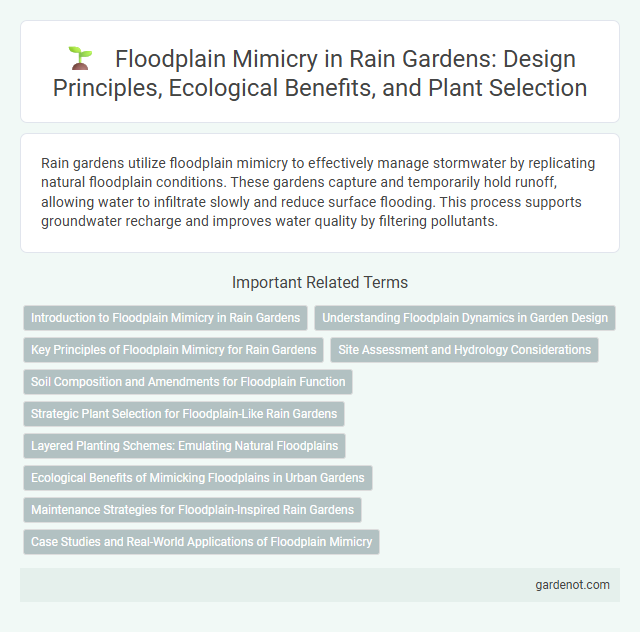Rain gardens utilize floodplain mimicry to effectively manage stormwater by replicating natural floodplain conditions. These gardens capture and temporarily hold runoff, allowing water to infiltrate slowly and reduce surface flooding. This process supports groundwater recharge and improves water quality by filtering pollutants.
Introduction to Floodplain Mimicry in Rain Gardens
Floodplain mimicry in rain gardens replicates natural floodplain functions by managing stormwater through soil absorption and temporary water storage. This design enhances groundwater recharge and reduces surface runoff, mitigating flooding risks. Incorporating native vegetation adapted to periodic saturation optimizes pollutant filtration and ecosystem support.
Understanding Floodplain Dynamics in Garden Design
Floodplain mimicry in rain garden design involves replicating natural floodplain dynamics to enhance water absorption and reduce runoff. By modeling soil composition, vegetation, and topography after natural floodplains, gardens improve groundwater recharge and support diverse ecosystems. Understanding these dynamics enables designers to create resilient landscapes that manage stormwater effectively and mitigate flooding risks.
Key Principles of Floodplain Mimicry for Rain Gardens
Floodplain mimicry in rain gardens involves replicating natural floodplain processes such as controlled water retention, gradual infiltration, and nutrient absorption to manage stormwater effectively. Key principles include designing shallow basins with native vegetation that tolerates periodic flooding, creating microtopography for water flow diversity, and ensuring soil composition supports high permeability and bioretention. Implementing these elements enhances groundwater recharge, reduces runoff velocity, and promotes ecosystem resilience.
Site Assessment and Hydrology Considerations
Site assessment for rain gardens involves analyzing soil permeability, slope, and natural drainage patterns to effectively mimic floodplain functions. Hydrology considerations include measuring peak flow rates and infiltration capacity to design a system that manages stormwater runoff while promoting groundwater recharge. Incorporating native vegetation adapted to periodic flooding enhances the garden's ability to reduce erosion and improve water quality.
Soil Composition and Amendments for Floodplain Function
Soil composition in rain gardens designed for floodplain mimicry prioritizes loamy textures with high organic matter to enhance water retention and nutrient cycling. Amendments such as compost and biochar improve soil structure and increase microbial activity, replicating natural floodplain processes. This optimized soil environment supports effective stormwater infiltration and pollutant filtration, crucial for sustainable floodplain function.
Strategic Plant Selection for Floodplain-Like Rain Gardens
Strategic plant selection for floodplain-like rain gardens emphasizes species adapted to periodic inundation and drought tolerance, ensuring resilience in fluctuating water conditions. Native wetland plants such as sedges (Carex spp.), rushes (Juncus spp.), and buttonbush (Cephalanthus occidentalis) replicate natural floodplain ecosystems by enhancing water absorption and sediment filtration. Incorporating deep-rooted perennials improves soil stability and supports biodiversity, creating functional rain gardens that effectively manage stormwater while mimicking natural floodplain hydrology.
Layered Planting Schemes: Emulating Natural Floodplains
Layered planting schemes in rain gardens emulate natural floodplains by integrating deep-rooted trees, water-tolerant shrubs, and diverse herbaceous plants to enhance water absorption and habitat complexity. This stratified vegetation structure improves floodplain mimicry by stabilizing soil, filtering runoff, and promoting groundwater recharge. Such designs optimize stormwater management while supporting biodiversity in urban landscapes.
Ecological Benefits of Mimicking Floodplains in Urban Gardens
Mimicking floodplains in urban gardens enhances biodiversity by creating habitats that support native flora and fauna adapted to periodic flooding. This approach improves water filtration and groundwater recharge, reducing surface runoff and mitigating urban flooding risks. Integrating floodplain characteristics in rain gardens promotes nutrient cycling and soil health, contributing to resilient urban ecosystems.
Maintenance Strategies for Floodplain-Inspired Rain Gardens
Maintenance strategies for floodplain-inspired rain gardens prioritize regular sediment removal to preserve infiltration capacity and prevent clogging of soil media. Seasonal inspection of plant health and replacement of native wetland vegetation ensures sustained ecosystem functionality and resilience. Incorporating adaptive management techniques, such as adjusting water flow pathways and repairing erosion damage, enhances long-term floodplain mimicry and stormwater management efficiency.
Case Studies and Real-World Applications of Floodplain Mimicry
Floodplain mimicry in rain garden design enhances stormwater management by replicating natural hydrological processes, as demonstrated in Seattle's Thornton Creek Water Quality Channel, which reduced urban runoff and improved water quality. In Portland, the Tryon Creek Watershed project applied floodplain principles to restore native vegetation and create flood storage, resulting in decreased peak flows and increased biodiversity. These case studies highlight how integrating floodplain mimicry into urban landscapes supports resilience against flooding while promoting ecological health.
Floodplain mimicry Infographic

 gardenot.com
gardenot.com